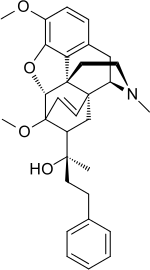7-PET
 | |
 | |
| Systematic (IUPAC) name | |
|---|---|
| (2R)-2-((4R,7S,7aR,12bS,14R)-7,9-dimethoxy-3-methyl-1,2,3,4,7,7a-hexahydro-7,4a-ethano-4,12-methanobenzofuro[3,2-e]isoquinolin-14-yl)-4-phenylbutan-2-ol | |
| Clinical data | |
| Identifiers | |
|
13965-63-4 | |
| PubChem | CID 203125 |
| ChemSpider |
21106246 |
| Chemical data | |
| Formula | C31H39NO4 |
| 487.64 g/mol | |
|
SMILES
| |
| |
| | |
7-PET was discovered by K.W. Bentley[1] and is a potent opioid analgesic drug, 300 times the potency of morphine by weight.[2] It is related to the more well-known oripavine derivative opioid etorphine, which is used as a very potent veterinary painkiller and anesthetic medication, used primarily for the sedation of large animals such as elephants, giraffes and rhinos. 7-PET itself has a 3-O-methyl ether which reduces potency, but the 3-OH derivative is around 2200x morphine, almost the same potency as etorphine as a μ agonist,[3][4] and unexpectedly the 3-desoxy compound is also around the same potency of 2000x morphine.[5]
Unlike etorphine however, 7-PET is not an illegal drug, and is not controlled under the UN drug conventions, but it might still be considered to be a controlled substance analogue of etorphine on the grounds of its related chemical structure in some jurisdictions such as the USA, Canada, Australia and New Zealand.
See also
- 14-Cinnamoyloxycodeinone
- 14-Phenylpropoxymetopon
- N-Phenethylnormorphine
- N-Phenethyl-14-ethoxymetopon
- Phenomorphan
- RAM-378
- Ro4-1539
References
- ↑ Bentley, K. W.; Hardy, D. G.; Meek, B. (1967). "Novel analgesics and molecular rearrangements in the morphine-thebaine group. II. Alcohols derived from 6,14-endo-etheno- and 6,14-endo-ethanotetrahydrothebaine". Journal of the American Chemical Society 89 (13): 3273–3280. doi:10.1021/ja00989a031. PMID 6042763.
- ↑ Lewis, J. W.; Bentley, K. W.; Cowan, A. (1971). "Narcotic Analgesics and Antagonists". Annual Reviews in Pharmacology 11: 241–270. doi:10.1146/annurev.pa.11.040171.001325. PMID 4948499.
- ↑ Feinberg, A. P.; Creese, I.; Snyder, S. H. (1976). "The opiate receptor: a model explaining structure-activity relationships of opiate agonists and antagonists" (pdf). Proceedings of the National Academy of Sciences of the United States of America 73 (11): 4215–4219. doi:10.1073/pnas.73.11.4215. PMC 431391. PMID 186791.
- ↑ Bentley, K. W.; Lewis, J. W. (1973). Kosterlitz, H. W.; Collier, H. O. J.; Villarreal, J. E., ed. Agonist and Antagonist Actions of Narcotic Analgesic Drugs. Baltimore: University Park Press. pp. 7–16. ISBN 978-0839107255. LCCN 72012612.
- ↑ Lewis, J. W.; Readhead, M. J. (1970). "Novel analgetics and molecular rearrangements in the morphine-thebaine group. XVIII. 3-Deoxy-6,14-endo-etheno-6,7,8,14-tetrahydrooripavines". Journal of Medicinal Chemistry 13 (3): 525–527. doi:10.1021/jm00297a041. PMID 5441135.